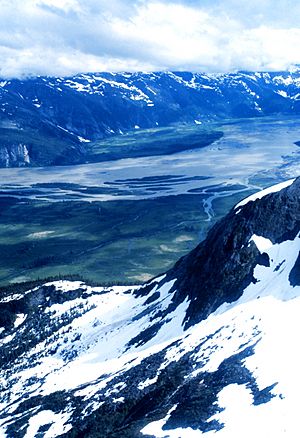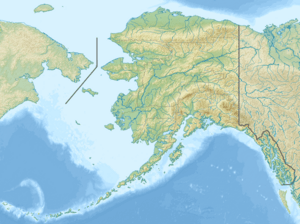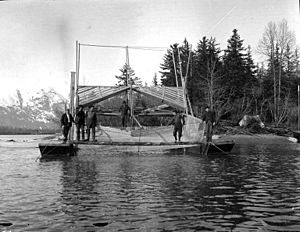Taku River facts for kids
Quick facts for kids Taku River |
|
|---|---|

Aerial view of the Taku River
|
|
|
Location of the mouth of the Taku River in Alaska
|
|
| Native name | T'aaḵu Héeni |
| Country | Canada, United States |
| State | Alaska |
| Province | British Columbia |
| Physical characteristics | |
| Main source | Inklin–Nakina confluence |
| River mouth | Pacific Ocean Stephens Passage, Alexander Archipelago, United States 58°25′35″N 133°58′38″W / 58.42639°N 133.97722°W |
| Length | 87 km (54 mi) |
| Basin features | |
| Basin size | 27,500 km2 (10,600 sq mi) |
The Taku River is a big river that flows from British Columbia, Canada, all the way to the coast of Alaska, near the city of Juneau. The area of land that drains into the Taku River is huge, covering about 27,500 square kilometres (10,600 sq mi).
This river is super important for salmon because many different types of salmon live and reproduce here. Most of the land around the Taku River is wild and untouched wilderness.
Contents
History of the Taku River
For a long time, the Taku Indians, who are part of the Tlingit nation, controlled the trade routes along the river. They acted as middlemen, meaning they helped trade goods between people living inland and white settlers. This way, they made sure they were part of all the trading.
Trading Posts on the Taku River
In the early 1840s, a company called the Hudson's Bay Company built a trading post near the mouth of the Taku River. This post was called Fort Durham, or sometimes Fort Taku. They hoped to use the river as a natural path for trade. However, by 1843, they closed Fort Durham because it wasn't making enough money.
Where Does the Taku River Start?
Even though the Taku is a major river, its name doesn't go all the way to its very beginning. The name "Taku River" officially starts where two other rivers meet: the Inklin River and the Nakina River. This meeting point is near a tiny community called Inklin.
Tributaries of the Taku River
The Inklin River itself is formed by the joining of the Nahlin River and the Sheslay River. The Nakina River's main branches are the Sloko River and the Silver Salmon River. Another important river that flows into the Taku River is the Tulsequah River.
What Does "Taku" Mean?
One idea is that "Taku" comes from a Tlingit word meaning "salmon." However, the Taku Tlingit people call themselves T'aaku Kwáan, which means "Geese Flood Upriver Tribe."
There are also two other Tlingit groups living inland in British Columbia. The Áa Tlein Kwáan (meaning "Big Lake Tribe") is now known as the Taku River Tlingit First Nation. Their land includes parts of the Taku River area in British Columbia. The Deisleen Kwáan (meaning "Big Sinew Tribe") is now called the Teslin Tlingit Council.
Why is the Taku River Important?
The Taku River is very important for the economies of Southeast Alaska and British Columbia. This is especially true for fishing, including commercial fishing (where people catch fish to sell), sport fishing (where people fish for fun), and personal-use fishing (where people catch fish for themselves and their families).
Economic Impact of the Taku River
A report from 2004 showed that fishing and processing fish from the U.S. side of the Taku River brought in $5.4 million. This also created 80 jobs and $1.4 million in wages. British Columbia added over $750,000 more to this amount.
Other activities also add to the local economy. These include commercial flights, guided river trips, hunting, and property taxes. The same report estimated that all activities on the Taku River together bring in about $26.7 million each year. A large part of this, about $18 million, comes from commercial air travel related to tourism.
Fish and Wildlife in the Taku River
The Taku River is the best salmon-producing river in Southeast Alaska. Data from the Alaska Department of Fish & Game shows that almost 2 million wild salmon return to the river every year. This includes many different types of salmon:
- Up to 100,000 Chinook salmon (also called king salmon)
- 350,000 sockeye salmon (red salmon)
- 400,000 coho salmon (silver salmon)
- 50,000 chum salmon (dog salmon)
- 1 million pink salmon (humpy salmon)
Besides salmon, the Taku River is home to eight other kinds of fish. These include steelhead, bull trout, Dolly Varden char, rainbow trout, lake trout, Arctic grayling, and whitefish. It also has the largest group of cutthroat trout in Southeast Alaska. Near the river's mouth, people also catch hooligans (eulachon), crab, shrimp, and halibut. All this marine life supports important sport, commercial, and tribal fisheries in Alaska and British Columbia.
Protecting the Taku River's Habitat
Because of past and possible future mining activities on the Canadian side of the border, the state of Alaska has taken steps to protect the river's habitat. In January 2009, the Alaska Department of Natural Resources approved a request to call the U.S. part of the Taku River "important habitat."
This special designation means that anyone wanting to get permits for using the river must try to "avoid, minimize, or reduce any major bad effects on the habitat's special productivity." Later, a small part of the U.S. river near the Canada–United States border had this designation removed. However, the "important habitat" designation still applies to a 16-mile (26 km) section of the river. This section starts at the river's mouth near Juneau, Alaska. Several groups, like Rivers Without Borders and the Alaska Marine Conservation Council, are working to get even more protection for the river's habitat.



